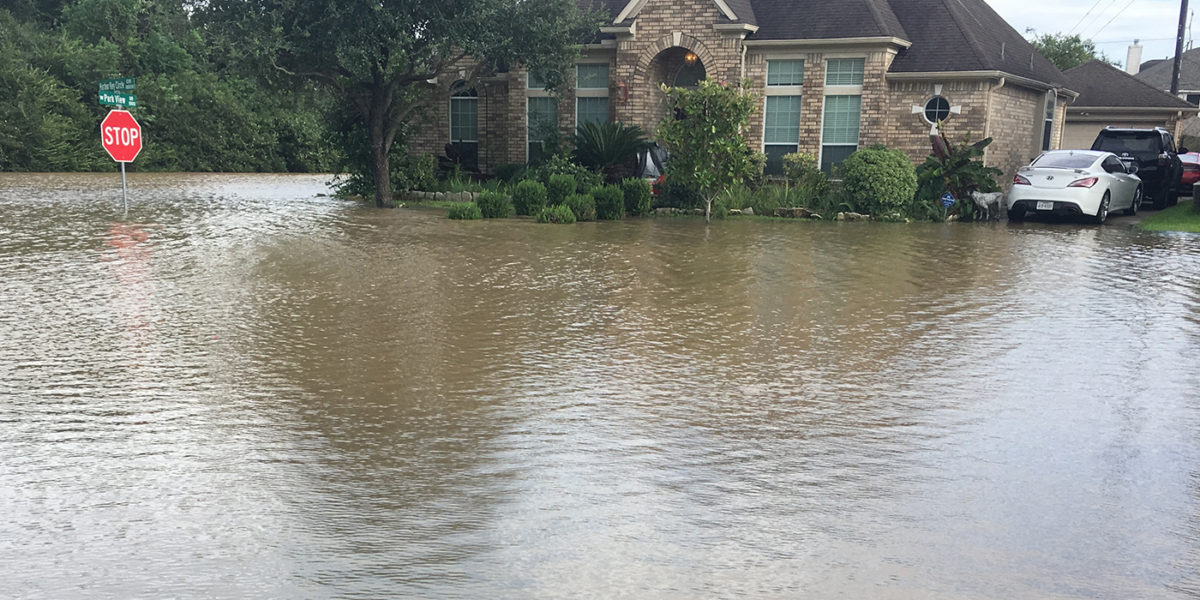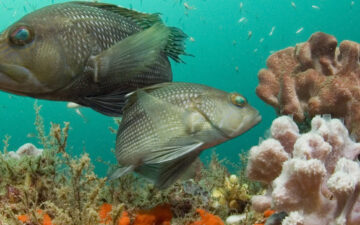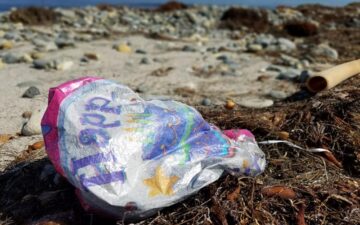“Where are you from?”
“Houston, Texas.”
“Oh, my goodness. I’m so sorry. How’s your family doing?”
“Good. All’s well that ends well.”
As a native Houstonian who has called Houston home all my (short) life, I’ve lived through Allison, Rita, Katrina, Ike, and now Harvey. From our home on the west side of Houston, we are not unfamiliar with floods. Generally, our neighborhood floods once a year for about a day, most of the time it occurs during the spring.

A neighbor leisurely canoes during the Tax Day flood outside our house on April 18, 2016.
And yet, no one foresaw Hurricane Harvey hitting as hard as it did. Much of the devastation Harvey left in Texas was less about the actual hurricane, and more about the torrential rains that came with it. This slow-moving storm lingered over Houston for several days, dropping substantial amounts of water over an extended period of time. The resulting rains inundated the fourth largest U.S. city and neighboring states with a total of 33 trillion gallons of water.1 Eventually, the majority of these waters found their way back to where they came from, the sea.2 However, they carried with them large amounts of pollutants, including chemicals from flooded refineries, toxic bacteria, and debris left in the streets.3

According to the National Weather Service, my side of town received between 30 to 40 inches of rain. 10
Gulf coastal wetlands have always been our first line of defense against impeding storms, but we put them, and ourselves, at risk when we fail to protect them.4 For example, we may be unsuccessful in defending these coastal wetlands, and instead leave them to be demolished in an effort to make way for establishments that may seem more profitable than leaving the wetlands there to protect against some future storm. Likewise, healthy coastal wetlands also filter water running off from the land, minimizing harm to the sea.
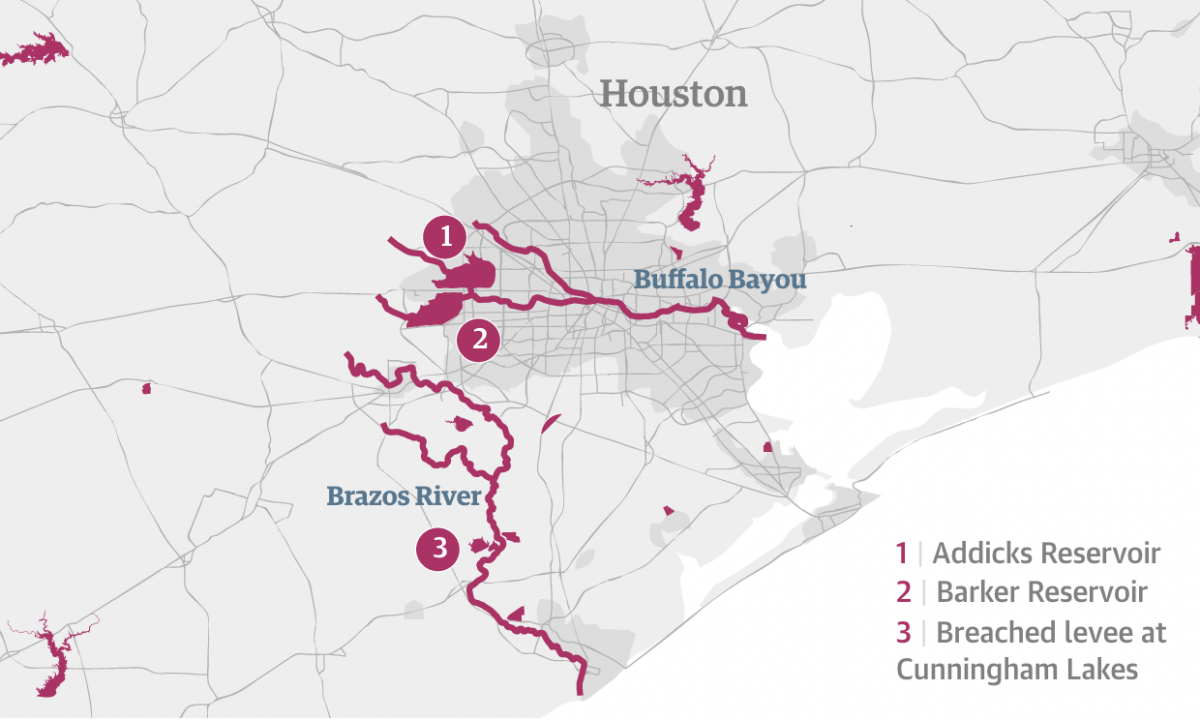
Upstream waters flowing into the Gulf of Mexico. 11
The coastal defense system can be harmed by other damaging environmental factors, such as the freshwater rains from Hurricane Harvey. Rainwater flows downstream from the Houston floodplains into the Gulf of Mexico, as does two-thirds of the United States’ freshwater.5 Even now, the freshwater dropped by Harvey still has yet to fully mix with the Gulf’s saltwater.6 Fortunately, despite low salinity values documented in the Gulf as a result of this “freshwater blob,” there have been no documented mass-die offs along coral reefs, largely in thanks to the direction in which these waters flowed away from these ecosystems. There has been little documentation of what new toxins may be found in nearshore areas and wetlands, left behind as the floodwaters drained down to the Gulf.
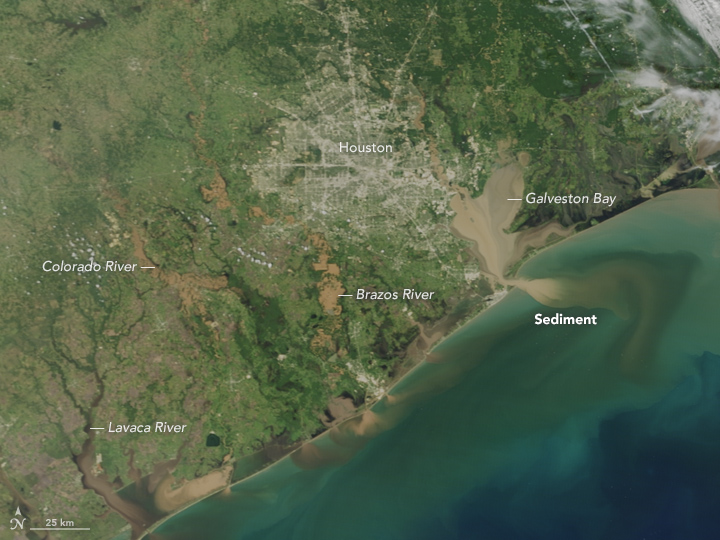
Sediments from Hurricane Harvey.12
Overall, Houston experienced such severe flooding because the city was built on a flat floodplain. Over time, expanding urbanization and lack of zoning codes further increases our risk of flooding as paved concrete roadways replace grasslands with little regard to the consequences of uncontrolled urban sprawl.7 For example, located just miles away from both the Addicks and Barker Reservoirs, our neighborhood encountered such prolonged flooding because the water levels remained stagnant. In order to ensure downtown Houston did not flood, officials deliberately chose to release the gates controlling the reservoirs, which led to the flooding of homes that were previously not expected to flood in West Houston.8 Hardscape materials such as asphalt and concrete tend to shed water rather than absorb it, so the water gathered onto streets and later found their way into the Gulf of Mexico.
(Day 4) A neighbor’s truck, one of up to a million that were flooded in the city. 13
Meanwhile, we spent over a week marooned in our house. The Coast Guard and volunteer boaters would often surge by and ask if we required rescue or provisions during our stay inside. Other neighbors went out to their front lawns and hung white cloths to their trees as a signal they would like to be rescued. When the waters receded on the tenth day of this 1,000 year flood event9 and we were finally able to walk outside without wading through water, the damage was astounding. The stench of raw sewage was everywhere and debris littered the pavement. Dead fish lay on the concrete streets and abandoned cars lined the roadways.
(Day 5) We used a stick to mark how high the waters were rising.
The day after we were free to roam outside, my family and I was scheduled to fly out to Minnesota for New Student Week at Carleton College. As we soared thousands of feet in the sky, I couldn’t help but think how we were one of the lucky ones. Our home was dry and our lives were not put at risk. However, I don’t know how lucky we will be the next time city officials decide that it is easier to flood our neighborhood than act to rebuild our defenses.
One thing that stuck with me was when my sixty year-old father said to me, “Well, I’m glad I’ll never have to see anything like this again in my lifetime.”
To which I responded, “I don’t know about that, Dad.”
“You think so?”
“I know so.”
(Day 6) My father and I waded through the waters to reach a gas station on a street corner. We requested a boat ride back home and I captured this devastatingly beautiful sight.
Andrew Farias is a member of the class of 2021 at Carleton College, who has just completed an internship in Washington, D.C.
1https://www.washingtonpost.com/news/capital-weather-gang/wp/2017/08/30/harvey-has-unloaded-24-5-trillion-gallons-of-water-on-texas-and-louisiana/?utm_term=.7513293a929b
2https://www.popsci.com/where-does-flood-water-go#page-5
3http://www.galvbay.org/news/how-has-harvey-impacted-water-quality/
4https://oceanfdn.org/blog/coastal-ecosystems-are-our-first-line-defense-against-hurricanes
5https://www.dallasnews.com/news/harvey/2017/09/07/hurricane-harveys-floodwaters-harm-coral-reefs-gulf-mexico
6http://stormwater.wef.org/2017/12/gulf-mexico-researchers-examine-effects-hurricane-harvey-floodwaters/
7https://qz.com/1064364/hurricane-harvey-houstons-flooding-made-worse-by-unchecked-urban-development-and-wetland-destruction/
8https://www.houstoniamag.com/articles/2017/10/16/barker-addicks-reservoirs-release-west-houston-memorial-energy-corridor-hurricane-harvey
9https://www.washingtonpost.com/news/capital-weather-gang/wp/2017/08/31/harvey-is-a-1000-year-flood-event-unprecedented-in-scale/?utm_term=.d3639e421c3a#comments
10 https://weather.com/storms/hurricane/news/tropical-storm-harvey-forecast-texas-louisiana-arkansas
11 https://www.theguardian.com/us-news/2017/aug/29/houston-area-impacted-hurricane-harvey-visual-guide
12 https://earthobservatory.nasa.gov/NaturalHazards/view.php?id=90866
